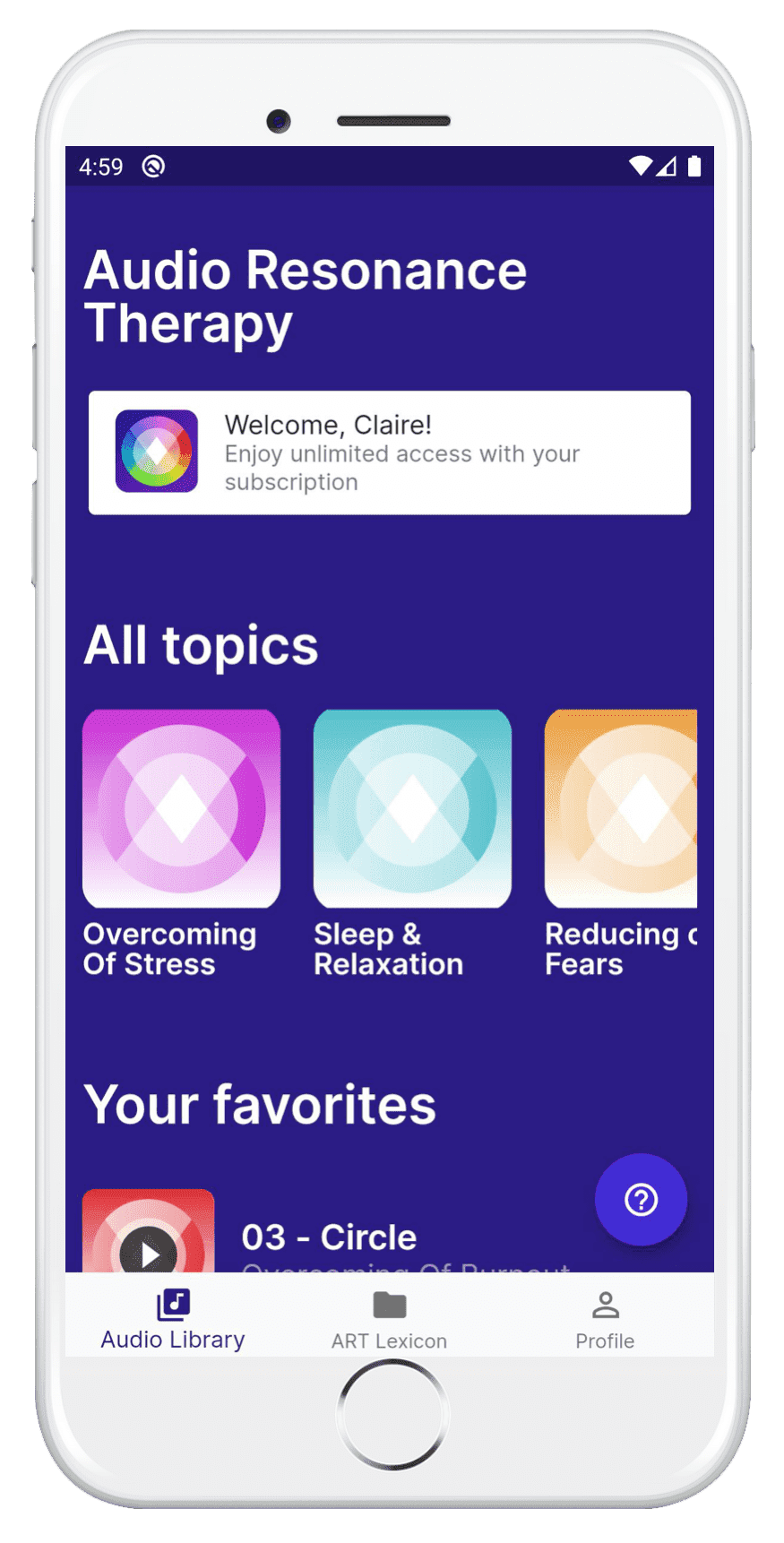Schwarz R (a), Hammes MG (a), Albrecht C (b), Reichardt D (b)
(a) MD Roya Schwarz, MD Michael G Hammes, Academy of Ancient Chinese Medicine, Hamburg, Germany
(b) Carl Albrecht, Dirk Reichardt, jamXmusic GmbH&Co KG, Hamburg, Germany
Key words: A.R.T., Audio Resonance Therapy ®, music, therapy, energy centres
SUMMARY
The effectiveness of certain sounds and tones on somatic stress management functions and on the autonomic nervous system as well as on the somatic and psychological state of mind were examined in the context of exposure to newly created compositions.
The recorded parameters include the heart rate variability and the mental state represented by the multi-dimensional state of the health questionnaire by certified criteria of the German Research Associaton, Deutsche Forschungsgesellschaft (DFG).
In addition, two study specific questionnaires were created, which essentially had to be answered according to operant criteria in order to enable an individual assessment of the subjects’ subjective experiences.
The study revealed an improvement of the state of mind in the dimensions of mood, alertness and inner peace immediately after the music meditation. This also led to a decrease in heart rate. The subjective assessment of the meditation experience was mostly positive and to a small extent neutral. The improvement in the state of health was still noticeable even 6 weeks after the end of the exercise phase. The positive subjective assessment of the meditation experience within the scope of the study only slightly decreased after 6 weeks.
CONCEPTUAL BACKGROUND
According to the teachings of old healing concepts, the physical body is penetrated and surrounded by a subtle resonance field, which encompasses a relatively wide range of different vibration areas. These vibrational areas form layers of different density, which interact strongly with each other, but nevertheless form clearly distinguishable levels, which are collectively referred to as the ‘bioplasmic field’. The frequency of the vibration increases exponentially to the distance from the physical body.
Different levels of vibration allow for different levels of experience. Just as the physical world can be experienced by the physical body, specific communication with intuition (inspiration) is possible via higher-frequency vibration fields.
The bioplasmic field also stores negative information and experiences (trauma) and, like the physical body, can be disturbed in its function.
The physical body expresses circumscribed areas of a specific connection with the bioplasmic field, so that this field can be positively influenced from theses areas.
These designated areas that map on the physical body are called energy centres.
These centres are the gate and the key for working with the fine vibrations and information that are reflected in the body.
Audio Resonance Therapy ® (A.R.T.) was developed taking into account different medical and scientific findings, as well as by using the complex interactions of different sound and composition techniques.
The A.R.T. sound sequences are tuned to a fundamental tone of 432 Hertz.
This 432 Hz orientation is considered to reflect a natural mood and was primarily inaugurated by the ancient mathematician Pythagoras. More recently the sound research of the physicist and astronomer Ernst Florens Friedrich Chladni confirmed its significance.
Audio Resonance Therapy ® takes advantage of the special resonance ability of the natural 432 Hertz mood. The focus on 8/256/432 Hertz (Schumann frequency, overtone octaves, Pythagorean sixth) creates an extensive field of activity for the development of sounds that can convey relaxation and well-being. The natural mood that is built up in this way affects different levels of cell biology and corresponds to the natural frequencies of the cells.
Modern basic research of harmony and the neurophysiology of music perception provide a better understanding.
Tones generated by therapy bowls have also been integrated into the Audio Resonance Therapy ®. With great professional effort, high-quality bowls were first recorded and then tempered and tuned to the music in their partial frequencies and partial tones.
The Audio Resonance Therapy ® was preceded by an elaborate sound study with different frequencies and moods for activating the body centres (chakras), which were examined and compared for their respective activating effects. For the A.R.T., only those frequencies and basic sounds that had proven to be the most effective in stimulating the individual body centres were selected.
In accordance with the diversity and significance of the energy systems in the understanding of Chinese medicine, other special sounds and frequencies were also added to the music.
Tones, sounds and sequences of harmony were chosen by us on the basis of their musical and compositional context according to findings from neurophysiology, brain and emotion research. It was intended to initiate a feeling of security, predictability, and reassurance.
A.R.T. sound sequences therefore spontaneously convey a feeling of satisfaction and provides the capacity to calm down and balance oneself in a unique way.
The A.R.T. study intended to examine this characteristic effect of A.R.T. music in detail.
Course of the study
In the sense of a dynamic stimulation, all body centres were activated in an ascending and descending order follow by a period of silence lasting several minutes subsiding the vibrations, thus unfolding the full effect of the A.R.T..
The test series for the A.R.T. study was carried out with 21 subjects over 21 days.
Before and after stimulation by music, the heart rate variability (HRV) was determined in the test subjects and a multidimensional condition measurement (MDBF) was carried out.
The multi-dimensional condition measurement (MDFB) was repeated on the indicated days as follows:
Day 1 Before and after the music exposure
Day 7 Before and after the music exposure
Day 14 Before and after the music exposure
Day 21 Before and after the music exposure
The heart rate variability measurement (HRV measurement) was carried out on the days listed below:
Day 1 Before and after the music exposure
Day 7 Before and after the music exposure
Day 14 Before and after the music exposure
Day 21 Before and after the music exposure
On day 21, probands were additionally underwent a specific subjective survey.
6 weeks after the end of the test series, the multidimensional condition measurement (MDFB) and an additional condition survey were carried out on the probands.
1. Overview of the findings after 21 days:
Multi-dimensional condition measurement (MDFB)
Study results
The following changes were observed for a majority of the probands:
GS score (good vs bad mood)
In a direct comparison before and after meditation, improvements towards a better mood were found in more than five out of six test persons.
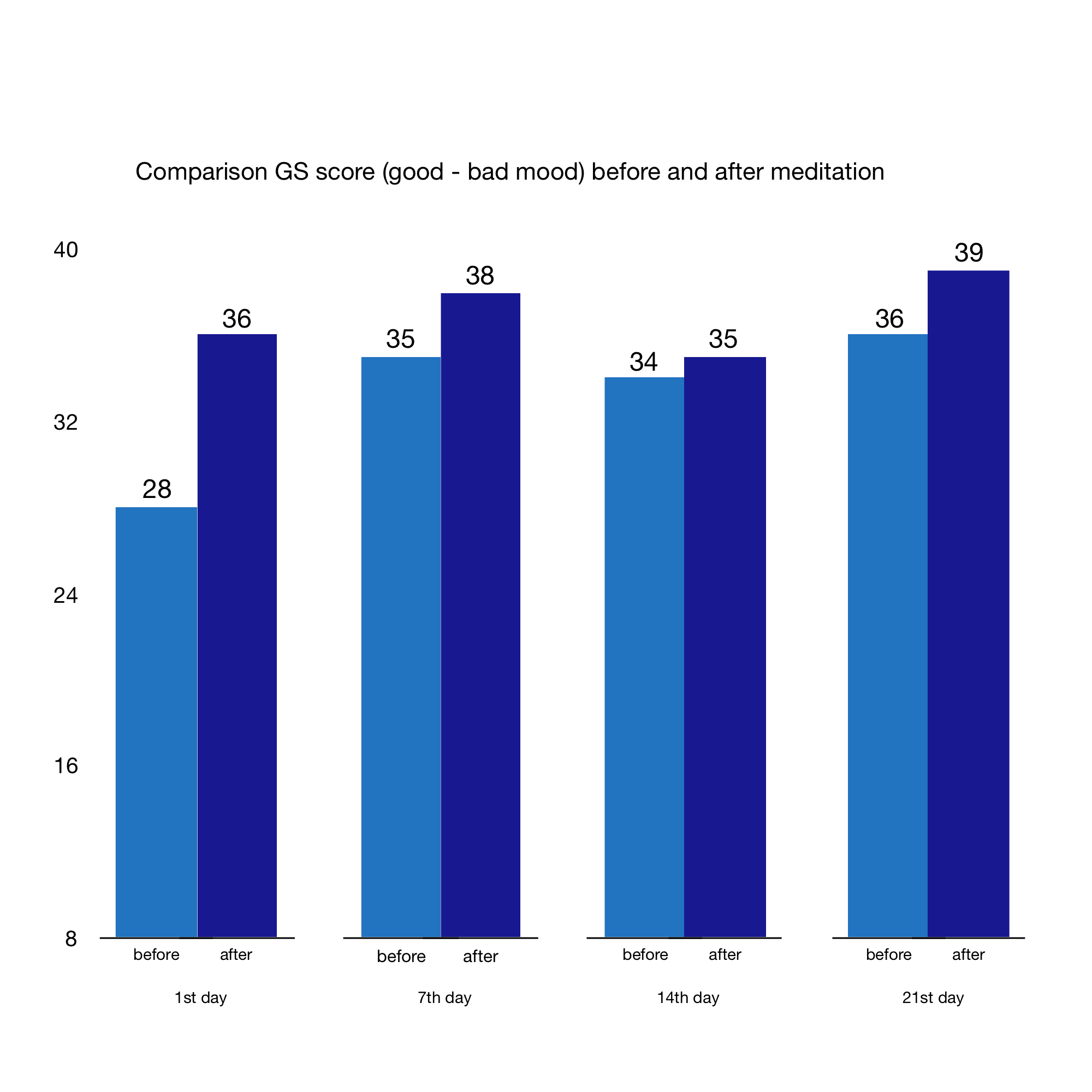
RU score (calm vs restless state)
In a direct comparison before and after meditation, more than five out of six test subjects also showed improvements towards a calmer state.
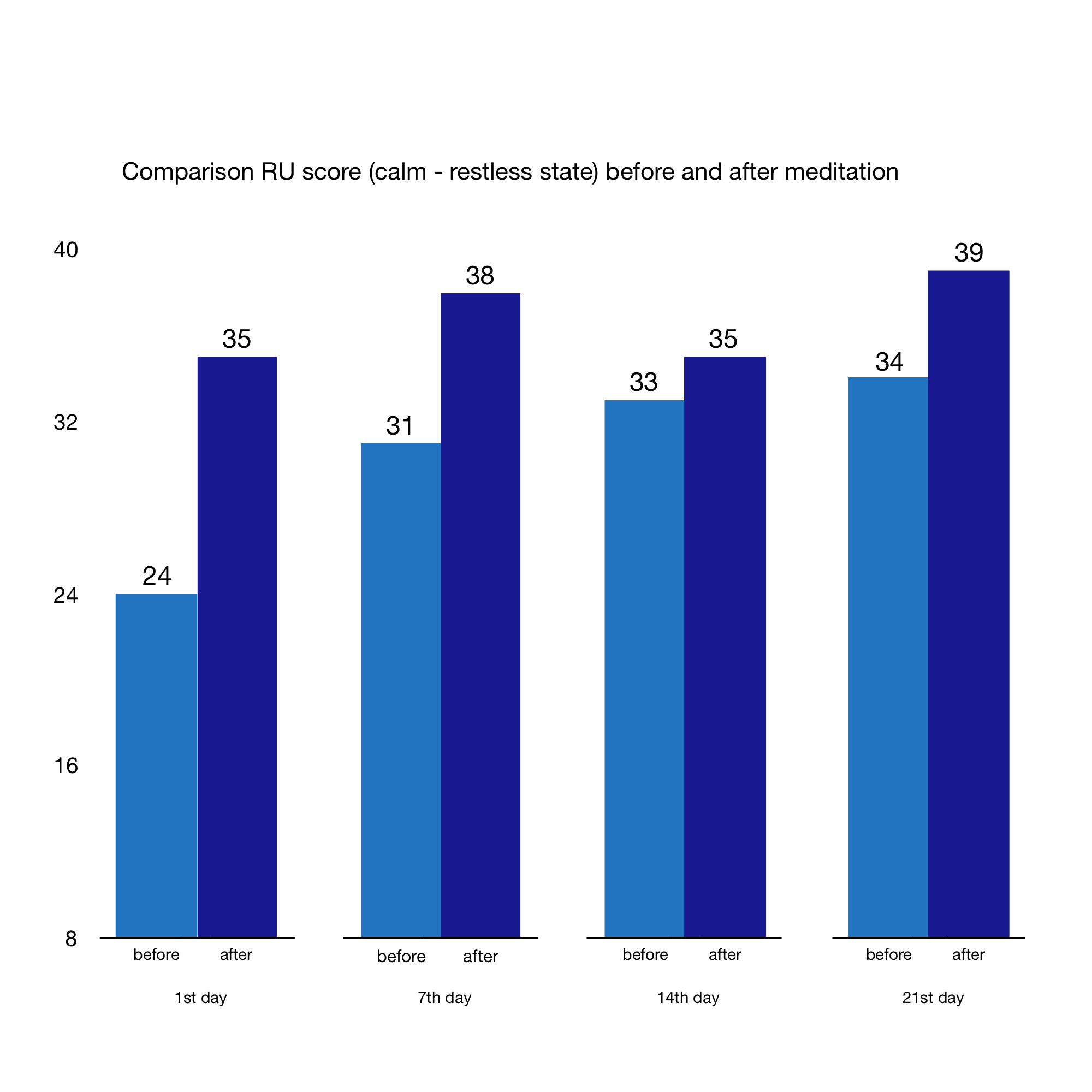
WM-Score (awake vs tired state)
In a direct comparison before and after meditation, more than three out of four test persons showed improvements towards a more vivid state.
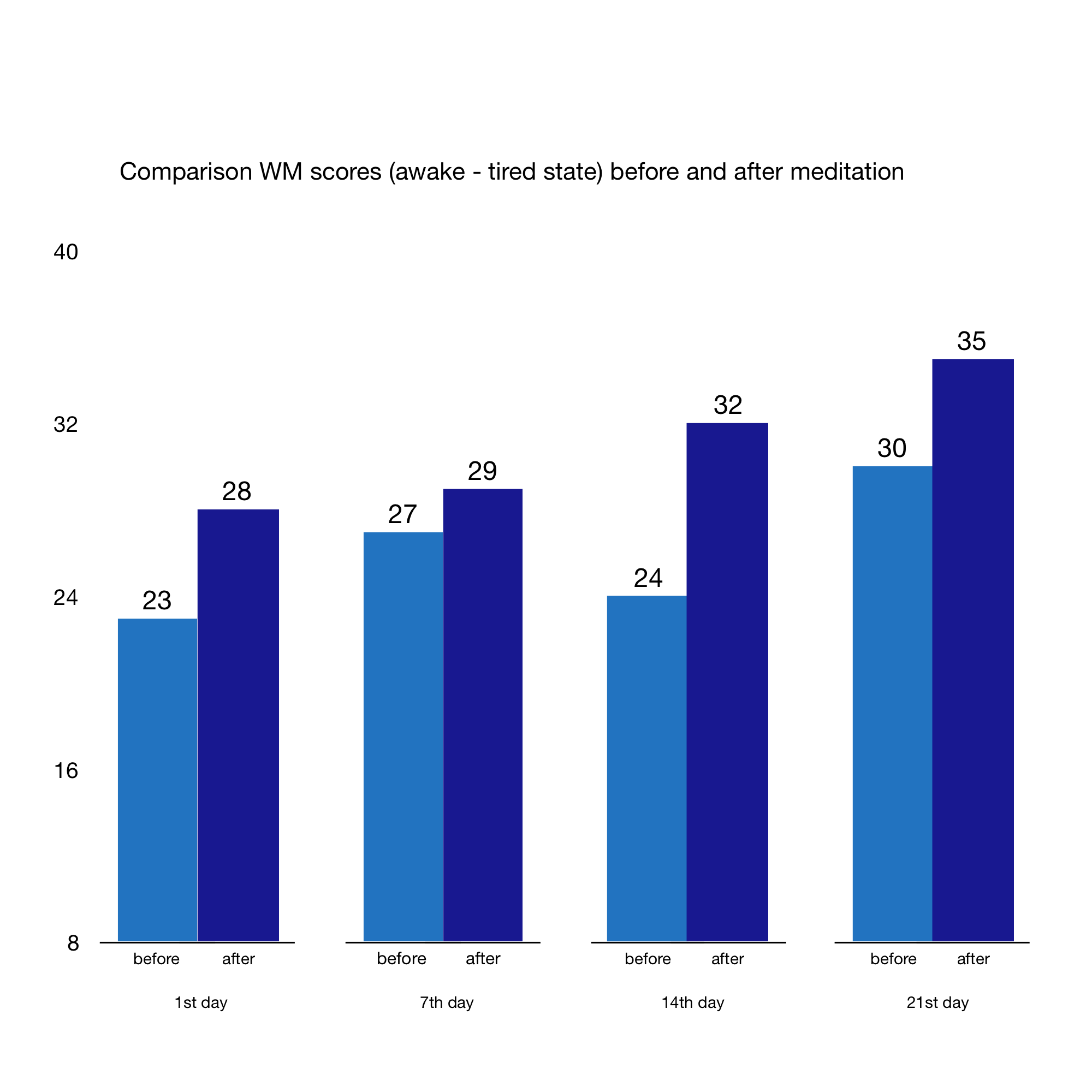
Heart rate variability (HRV)
An average of more than five out of six test subjects showed a reduction in the heart rate with an average of -4% after meditation in the evaluation of all examination courses. In the first rounds, this reduction was even seen in nine out of ten or up to twenty of the twenty-one subjects. After the last round, there was a special situation due to the presentation of gifts, applause and discussions between the participants, so that only some seven out of ten test subjects showed a reduced heart rate. The majority of the study participants were patients with severe or chronic diseases, which is reflected in the distribution of the spectrum of low heart rates that are related to vegetative regulation.
Subjective condition survey
The anonymized form contained questions with a three-part answer option (applicable, not applicable, do not know). The following results were summarized:
19 out of 21 participants affirmed the observation of a positive change
all participants found the study participation to be predominantly pleasant
all participants would recommend A.R.T. meditation
17 out of 21 participants felt an improvement in vitality
20 out of 21 participants experienced the dissolving of internal blockages
16 out of 21 participants reported an improvement in physical health
all participants noticed an improvement in their mental and emotional state
19 out of 21 participants found the music of A.R.T. meditation to be more positive than other meditative music
18 out of 21 participants saw it as very likely to integrate A.R.T. therapy into their everyday life, the remaining three participants described it as probable.
2. Overview of the findings at the beginning and end of the study and after 6 weeks:
Multi-dimensional condition measurement (MDFB)
Overview of the results
The surveys were carried out immediately before and after the study and six weeks after the end of the study:
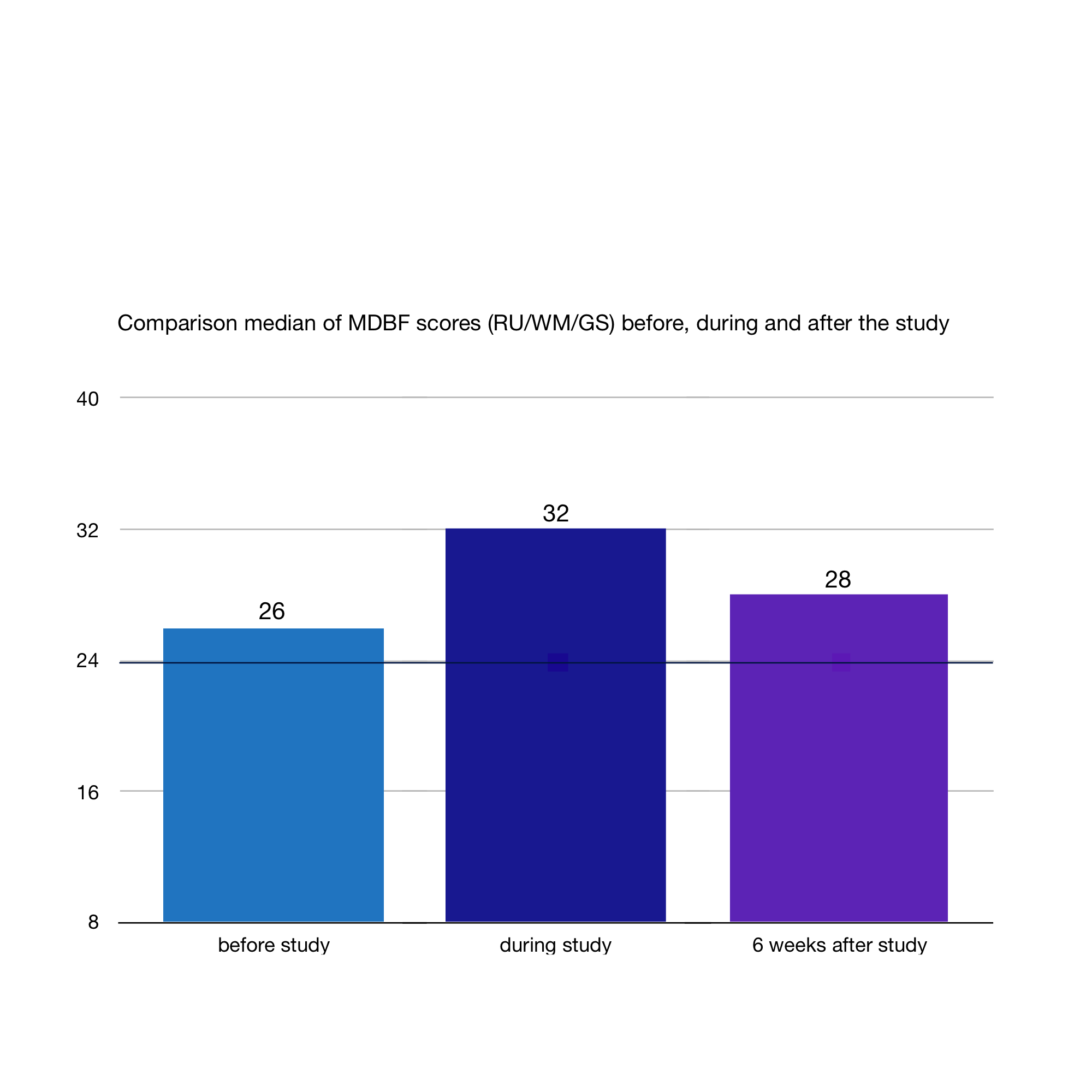
A.
In 71% of the subjects, feeling of being awake vs tired during the study was better than when they had started or 6 weeks after the study.
In 81% of the subjects, the good vs bad condition during the study was better than when they had started or 6 weeks after the study.
In 86% of the subjects, the rest vs agitation during the study was better than when they had started or 6 weeks after the study.
Overall health was better with 79% of subjects during the study than before or 6 weeks after the study.
B.
Feeling awake vs tiredness improved by 14% during the study compared to before or 6 weeks after the study.
The good vs bad condition was improved by 11% during the study compared to before or 6 weeks after the study.
Rest vs agitation was by 17% better during the study compared to before or 6 weeks after the study.
Overall health was by 14% better on average during the study than before or 6 weeks after the study.
C.
In 52% of the subjects, the feeling awake vs tired state was better 6 weeks after the study than when they had started the study.
In 57% of the subjects, the good vs bad condition was better 6 weeks after the study than when entering the study.
In 71% of the subjects, the rest vs restless condition was better 6 weeks after the study than when they had started the study.
In about 60% of the test subjects, the overall condition was on average better 6 weeks after the study.
Average changes in the overall group are shown here. The results of the investigation showed considerable inter-individual differences. In particular, subjects with exceptionally high or low input scores sometimes showed no relevant changes in the evaluated scores, contrary to the trends of the whole group.
Due to the structure of the MDFB, the value of a middle score balanced between the two poles is 24 (lowest possible value 8, highest possible value 40: 24 ± 16). Values above the middle level of 24 are to be understood as a stronger expression of a condition that is perceived as positive, values below this threshold indicate a stronger expression of a condition that is perceived as negative. The highest average values achieved in the study for the three examined scores are distributed as follows:
Feeling Awake vs Tired Score – 29 (24 + 5)
Good vs Bad Score – 34 (24 + 10)
Rest vs Restlessness Score – 33 (24 + 9)
Subjective health state questionnaire
90% of the subjects stated that they had lasting effects from participating in the A.R.T. study.
90% of the test persons stated that their mental state was consolidated through participating in the A.R.T. programme.
81% of the respondents felt that by participating in the A.R.T. programme they are responding differently to the global crisis.
71% of the subjects stated that they had generally less fear of the future since participating in the study, which was regarded as an effect of A.R.T. meditation.
The subjects most often used the following attributes to describe the impact of the A.R.T. programme:
calmer / composed / centered: 7 out of 21 (33%)
calmly / relaxed: 5 out of 21 (24%)
more trusting: 4 out of 21 (19%)
Further findings
During the four music meditation sessions (first, seventh, fourteenth and twenty-first day of the study), the rest vsrestlessness score (MDBF) was higher in all four runs in 10.5% of the test subjects at the end of meditation compared to the situation before music exposure (change towards grown calmness). The strongest manifestation of this effect was observed after the first exposure to music with an increase of 43%.
In 7% of the subjects, the feeling awake vs tired score (MDBF) was higher in all four runs at the end of the meditation compared to the situation before music exposure (change towards increased fatigue). The strongest manifestation of this effect was observed after the first exposure to music with an increase of 20%.
In 6.5% of the test persons, the good vs bad score (MDBF) was higher in all four runs at the end of the meditation than before the music exposure (change towards better feeling). The strongest manifestation of this effect was observed after the first exposure to music with an increase of 19%.
The median of the three condition markers evaluated was on average for all four runs at the end of meditation 8% higher than before the music exposure (change towards better overall condition).
WHAT OUR USERS SAY
